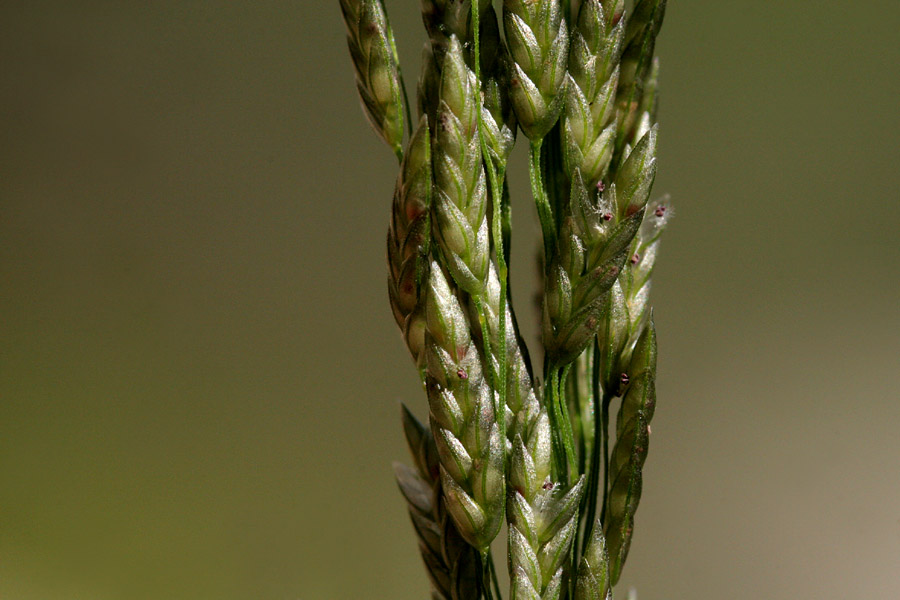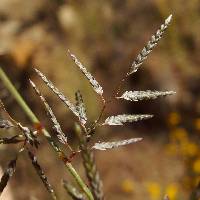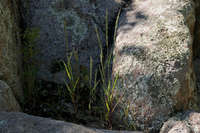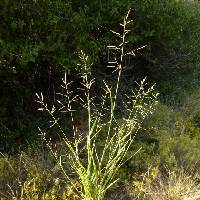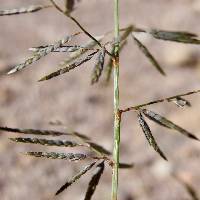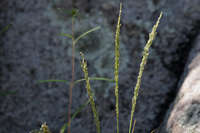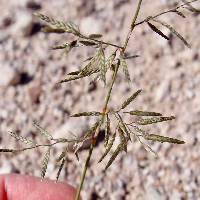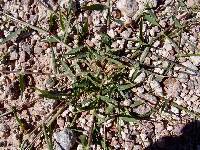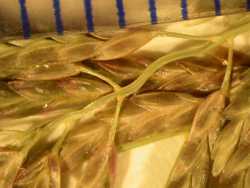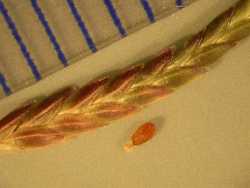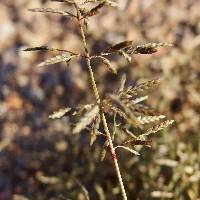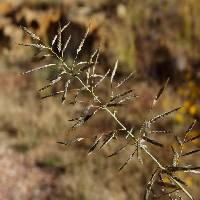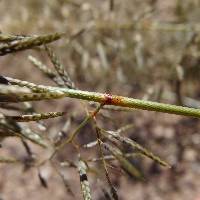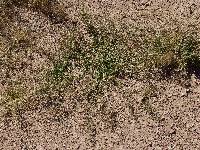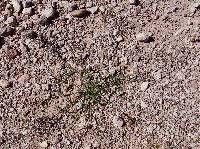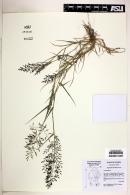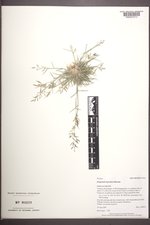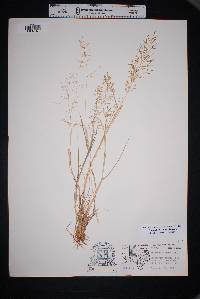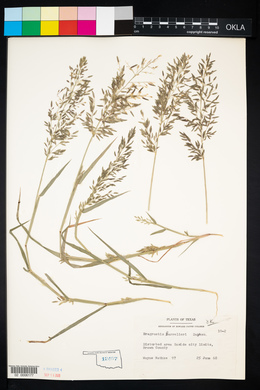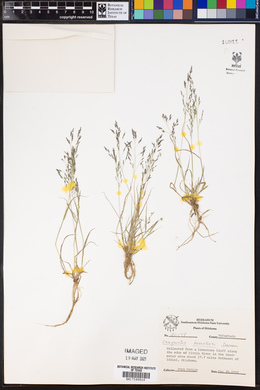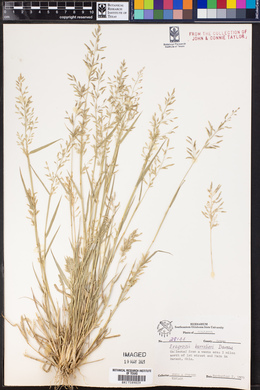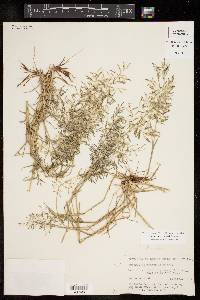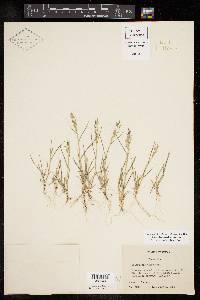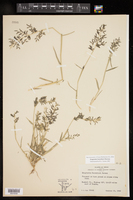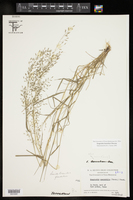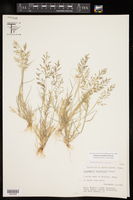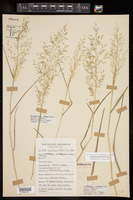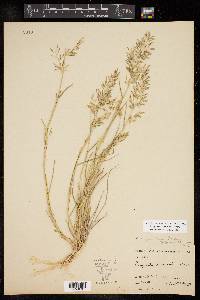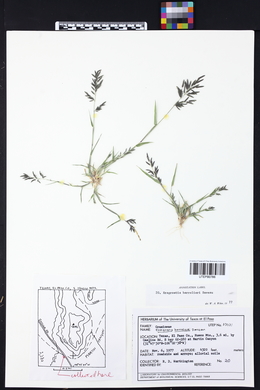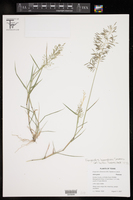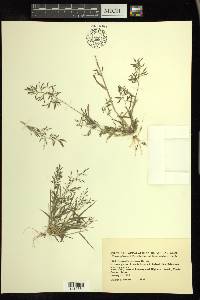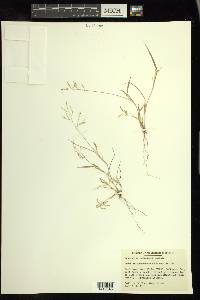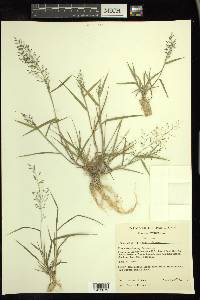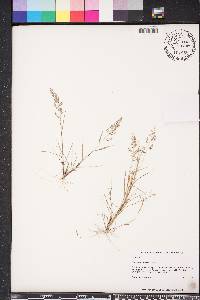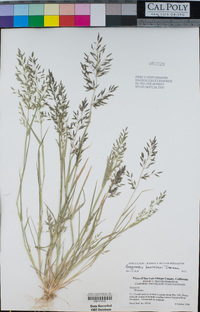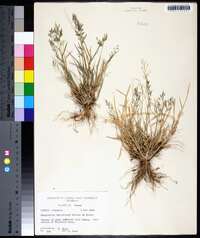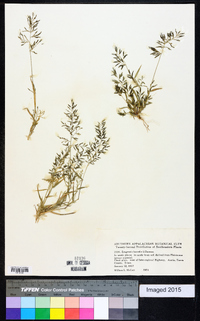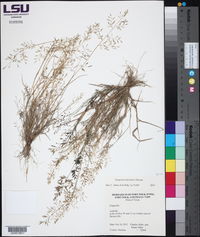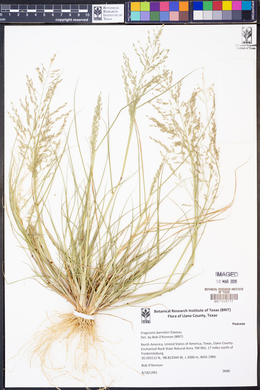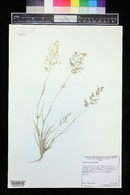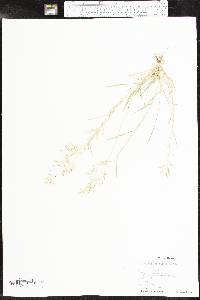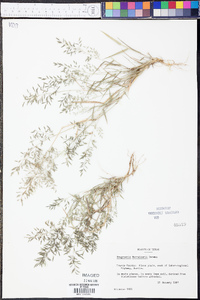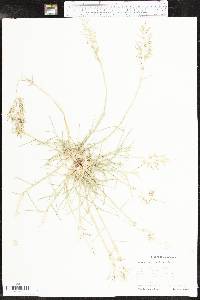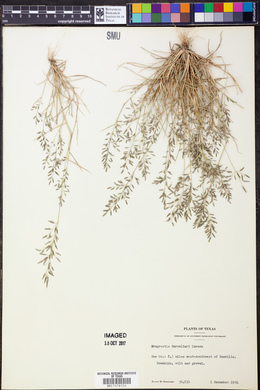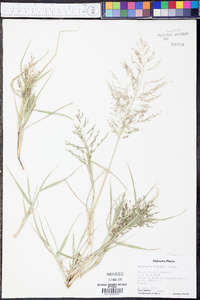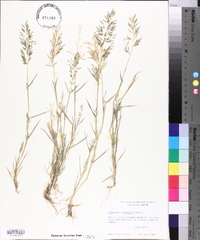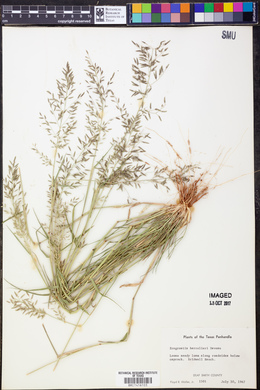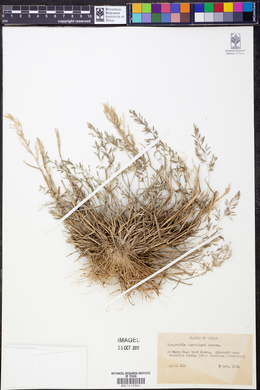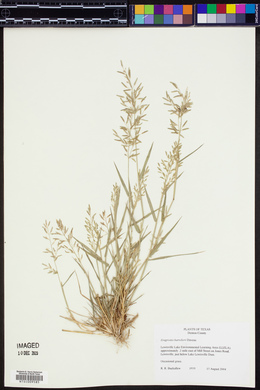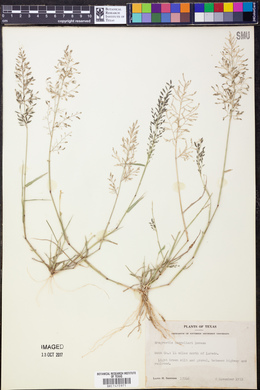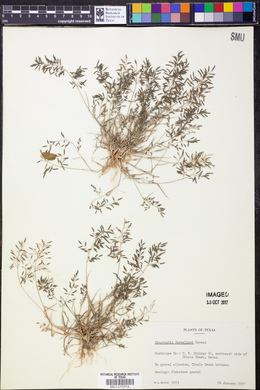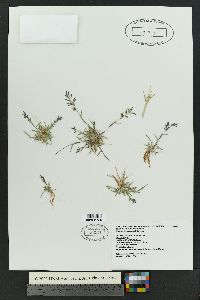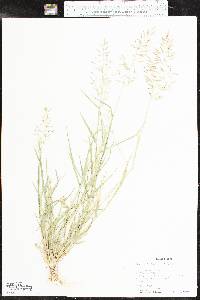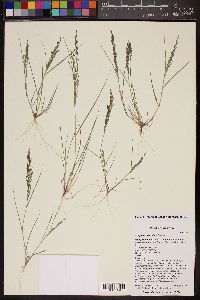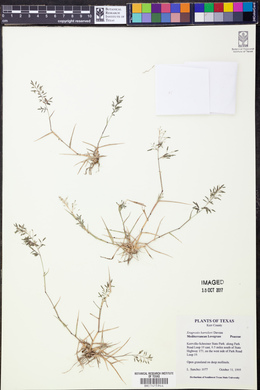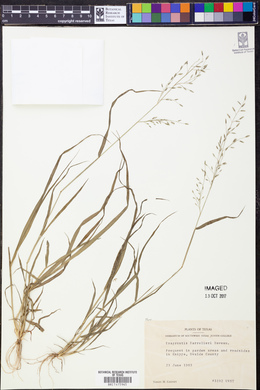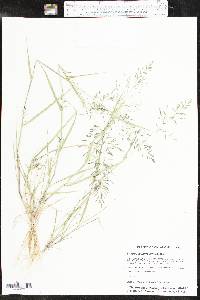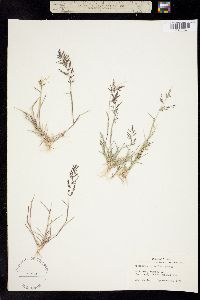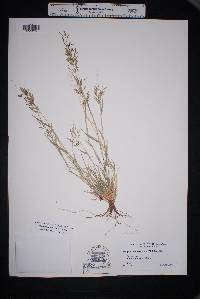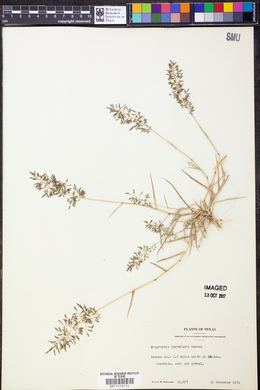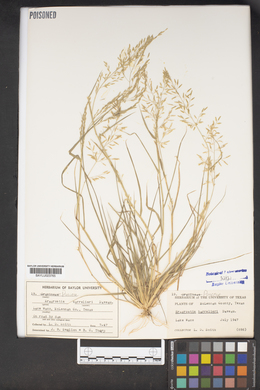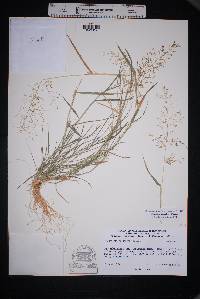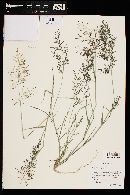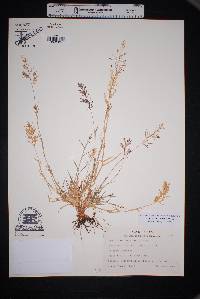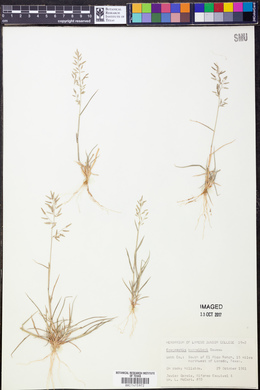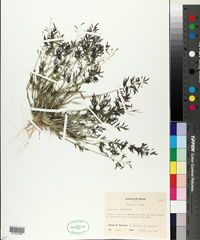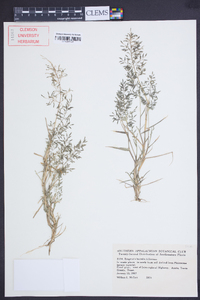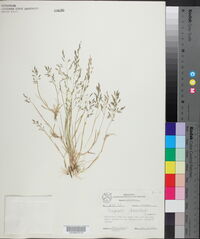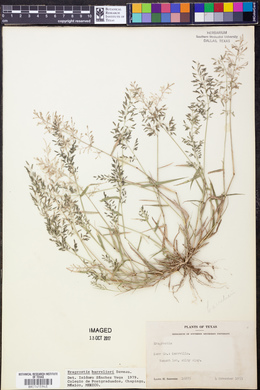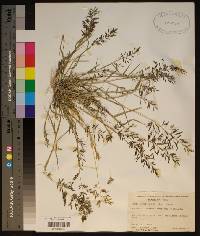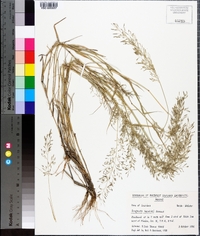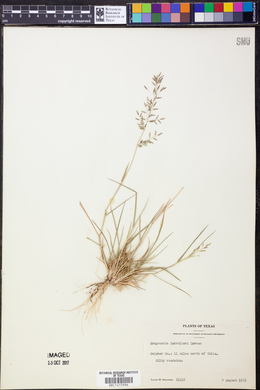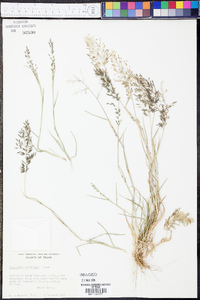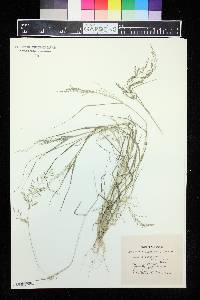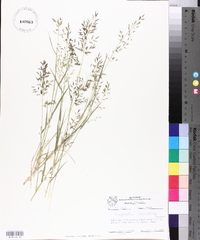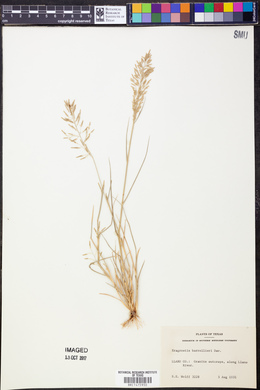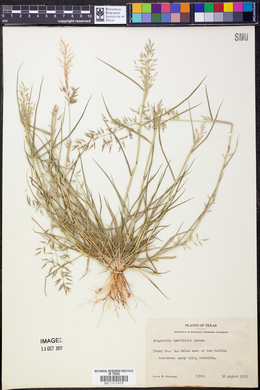
|
|
|
|
Family: Poaceae
Mediterranean Love Grass, more...Mediterranean lovegrass
[Eragrostis insulatlantica A. Chev., moreEragrostis poaeoides var. barrelieri (Daveau) Fiori, Eragrostis vulgaris subsp. barrelieri (Daveau) R.C.V. Douin] |
Plants annual; tufted, without innovations. Culms (5)10-60 cm, erect or decumbent, much-branched near the base, with a ring of glandular tissue below the nodes, rings often shiny or yellowish. Sheaths hairy at the apices, hairs to 4 mm; ligules 0.2-0.5 mm, ciliate; blades 1.5-10 cm long, 1-3(5) mm wide, flat, abaxial surfaces glabrous, adaxial surfaces glabrous, sometimes scabridulous, occasionally with white hairs to 3 mm, margins without crateriform glands. Panicles 4-20 cm long, 2.2-8(10) cm wide, ovate, open to contracted, rachises with shiny or yellowish glandular spots or rings below the nodes; primary branches 0.5-6 cm, diverging 20-100° from the rachises; pulvini glabrous; pedicels 1-4 mm, stout, stiff, divergent, without glandular bands. Spikelets 4-7(11) mm long, 1.1-2.2 mm wide, narrowly ovate, reddish-purple to greenish, occasionally grayish, with 7-12(20) florets; disarticulation acropetal, paleas persistent. Glumes broadly ovate, membranous, 1-veined; lower glumes 0.9-1.4 mm; upper glumes 1.2-1.6 mm; lemmas 1.4-1.8 mm, broadly ovate, membranous, apices acute to obtuse; paleas 1.3-1.7 mm, hyaline, keels scabrous, scabridities to 0.1 mm, apices obtuse to acute; anthers 3, 0.1-0.2 mm, reddish-brown. Caryopses 0.4-0.7 mm, ellipsoid, not grooved, smooth to faintly striate, light brown. 2n = 40. Eragrostis barrelieri is a European species that is now naturalized in the Flora region, primarily in the southwestern United States. It grows on gravelly roadsides, in gardens, and other disturbed, sandy sites, especially near railroad yards, at 10-2000 m. The ring of glandular tissue is most conspicuous below the upper cauline nodes. Dr. David Bogler, USDA NRCS PLANTS Database Annuals, Terrestrial, not aquatic, Stems nodes swollen or brittle, Stems geniculate, decumbent, or lax, sometimes rooting at nodes, Stems caespitose, tufted, or clustered, Stems terete, round in cross section, or polygonal, Stem internodes solid or spongy, Stem internodes hollow, Stems with inflorescence less than 1 m tall, Stems, culms, or scapes exceeding basal leaves, Leaves mostly basal, below middle of stem, Leaves mostly cauline, Leaves sheathing at base, Leaf sheath mostly open, or loose, Leaf sheath smooth, glabrous, Leaf sheath hairy at summit, throat, or collar, Leaf sheath and blade differentiated, Leaf blades linear, Leaf blades very narrow or filiform, less than 2 mm wide, Leaf blades 2-10 mm wide, Leaf blades mostly flat, Leaf blade margins folded, involute, or conduplicate, Leaf blades mostly glabrous, Leaf b lades glaucous, blue-green, or grey, or with white glands, Ligule present, Ligule a fringe of hairs, Inflorescence terminal, Inflorescence an open panicle, openly paniculate, branches spreading, Inflorescence solitary, with 1 spike, fascicle, glomerule, head, or cluster per stem or culm, Inflorescence branches more than 10 to numerous, Flowers bisexual, Spikelets pedicellate, Spikelets dorsally compressed or terete, Spikelet less than 3 mm wide, Spikelets with 3-7 florets, Spikelets with 8-40 florets, Spikelets solitary at rachis nodes, Spikelets all alike and fertille, Spikelets bisexual, Spikelets disarticulating above the glumes, glumes persistent, Spikelets disarticulating beneath or between the florets, Rachilla or pedicel glabrous, Glumes present, empty bracts, Glumes 2 clearly present, Glumes equal or subequal, Glumes distinctly unequal, Glumes shorter than adjacent lemma, Glumes 1 nerved, Lemmas thin, chartaceous, hyaline, cartilaginous, or membranous, Lemma similar in texture to glumes, Lemma 3 nerved, Lemma glabrous, Lemma apex truncate, rounded, or obtuse, Lemma awnless, Lemma margins thin, lying flat, Lemma straight, Palea present, well developed, Palea membranous, hyaline, Palea shorter than lemma, Palea 2 nerved or 2 keeled, Palea keels winged, scabrous, or ciliate, Stamens 3, Styles 2-fid, deeply 2-branched, Stigmas 2, Fruit - caryopsis, Caryopsis ellipsoid, longitudinally grooved, hilum long-linear.
FNA 2003, Gould 1980, USDA GRIN Common Name: Mediterranean lovegrass Duration: Annual Nativity: Non-Native Lifeform: Graminoid General: Tufted annual grass, stems erect to spreading, geniculate or decumbent at the base, branching at base, rings or patches of shiny yellow or pink- purplish glandular tissue on stems, inflorescence axes, and branches. Vegetative: Sheaths one-half the length of the internodes, glabrous except for pilose apex of margins; ligule a dense row of white hairs about 0.5 mm long; blades flat to involute, glabrous below, scabrous and scattered pilose above, 3-10 cm long, 1-5 mm wide. Inflorescence: Panicles ovoid and open, 5-16 cm long, 2-8 cm wide, rachis scabrous towards tip, branches ascending to spreading, glabrous, and often bearing spikelets nearly to the base; spikelets linear to oblong, straw-to-lead colored, flattened, 5-11 mm long, 1-1.5 mm wide, 6-15 flowered with a persistant rachilla; glumes ovate, acute to acuminate, hyaline, scabrous on keels; lower glume 1-1.5 mm, upper glume slightly longer; lemmas 2 mm; caryopsis cylindric, oblique at one end, pointed at other. Ecology: Found on roadsides and on disturbed ground, below 6,000 ft (1829 m); flowers August-October. Distribution: Native to Africa, Asia, and southern Europe. Naturalized in North and South America and Australia. Found throughout most of the southern half of the US, especially in AZ, NM and s. CA. Notes: A common weedy annual grass, introduced from Europe. The prominent glandular rings or patches are unique among the grasses in Arizona and Sonora. Look for the glandular rings especially below the upper stem nodes, where they are most conspicuous. Ethnobotany: Unknown Etymology: Eragrostis is from Greek eros, love and agrostis, grass, while barrelieri is named for the French botanist Jacques Barrelier (1606-1673). Synonyms: None Editor: SBuckley 2010, FSCoburn 2015, AHazelton 2015 |
|
|
|

